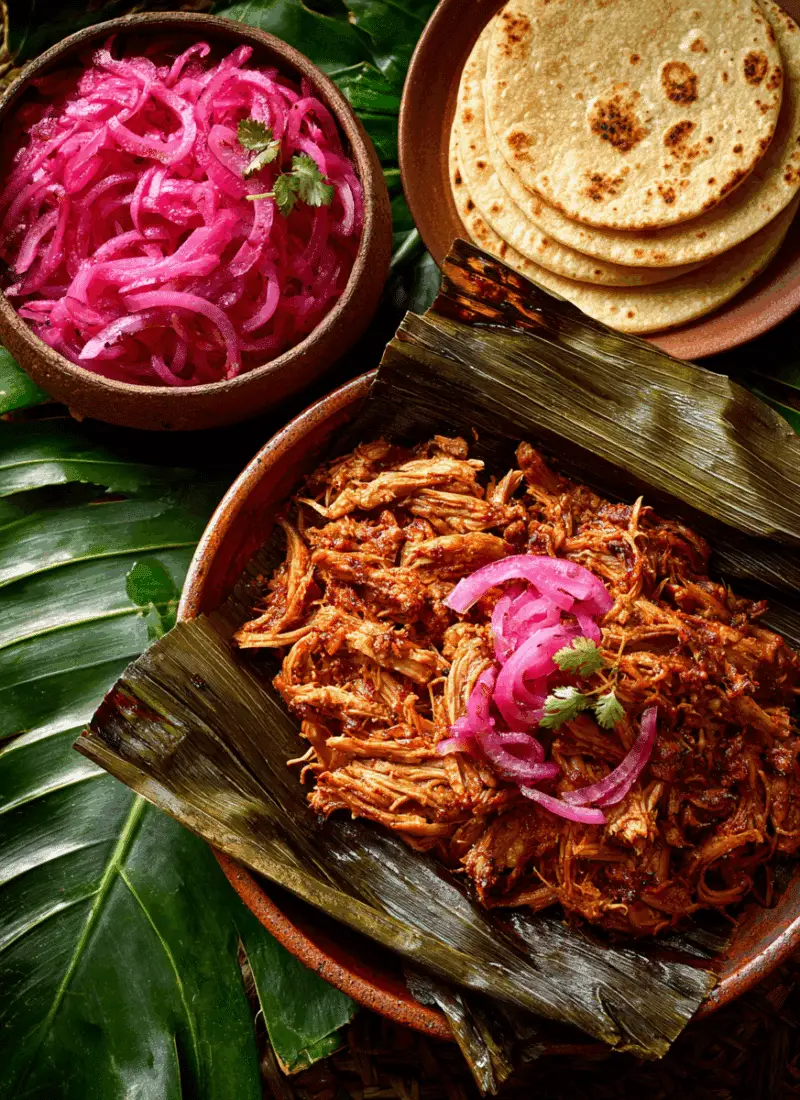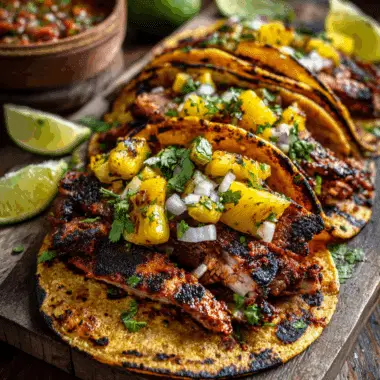Cochinita Pibil is a traditional Mexican dish from the Yucatán Peninsula, known for its rich, tangy, and deeply flavorful profile. Originally made with whole suckling pig, this modern version features pork marinated in achiote paste, citrus juices, and spices, then slow-roasted until tender. Wrapped in banana leaves and traditionally cooked underground, it’s now easily prepared in a home oven while preserving its bold, authentic taste.
FULL RECIPE
Ingredients
- 3 lbs pork shoulder or butt, cut into large chunks
- 1/2 cup achiote paste
- 1/2 cup orange juice (preferably fresh)
- 1/4 cup lime juice
- 1/4 cup white vinegar
- 6 garlic cloves, minced
- 1 tbsp oregano (preferably Mexican oregano)
- 1 tsp ground cumin
- 1 tsp salt
- 1/2 tsp ground cinnamon
- 1/2 tsp ground allspice
- 1/4 tsp ground cloves
- 2 bay leaves
- 1 banana leaf (or aluminum foil, if unavailable)
- Pickled red onions (for garnish, optional)
- Corn tortillas (for serving, optional)
Directions
- Prepare the marinade: In a bowl, combine achiote paste, orange juice, lime juice, white vinegar, garlic, oregano, cumin, salt, cinnamon, allspice, and cloves. Mix well until a smooth marinade forms.
- Marinate the pork: Place the pork chunks in a large bowl or zip-top bag. Pour the marinade over the meat, ensuring all pieces are coated. Cover or seal, and refrigerate for at least 6 hours, preferably overnight.
- Preheat the oven: Set the oven to 325°F (163°C).
- Wrap and roast: Line a baking dish with banana leaf (or foil). Place the marinated pork and bay leaves in the center. Fold the leaf/foil over the meat to seal it. Cover the dish tightly with foil if using banana leaves.
- Cook the pork: Roast in the oven for 3 to 4 hours or until the meat is very tender and easy to shred with a fork.
- Shred and mix: Remove from the oven, discard bay leaves, and shred the pork in its juices. Mix well to absorb the marinade.
- Serve: Serve hot with pickled red onions and warm corn tortillas for tacos, or over rice.
Nutrition Facts
- Calories: 420
- Protein: 34g
- Fat: 27g
- Saturated Fat: 9g
- Carbohydrates: 6g
- Fiber: 1g
- Sugars: 2g
- Sodium: 710mg
- Cholesterol: 110mg
Flavor Profile and Seasoning
The bold flavor of Cochinita Pibil comes from its complex marinade. Achiote paste, made from annatto seeds, gives the pork its deep red hue and earthy, slightly peppery taste. When combined with sour orange or citrus juice, garlic, and warm spices like cloves and cinnamon, the result is a tangy, aromatic, and robust marinade. The flavors are well-balanced, allowing the pork to absorb both zest and spice during long marination and slow cooking. This makes the dish both savory and slightly acidic, with a tender, melt-in-the-mouth texture.
Health Benefits of Ingredients
Cochinita Pibil may be indulgent, but it includes several ingredients with nutritional benefits. Achiote contains antioxidants and antimicrobial properties. Citrus juice is high in vitamin C, which supports immune function. Garlic is well-known for its anti-inflammatory and heart-health-promoting compounds. While pork shoulder is high in protein, it also contains essential vitamins like B12 and zinc. When served in moderation with healthy sides like pickled vegetables and corn tortillas, the dish can be part of a balanced, nutrient-dense meal.
Modern Cooking Adaptations
While traditional Cochinita Pibil is cooked underground, modern kitchens have adapted the recipe to be oven-friendly without compromising on flavor. Wrapping the marinated pork in banana leaves helps replicate the earthy, steamed effect of the traditional cooking method. Alternatively, foil can be used when banana leaves are unavailable. Slow cookers and pressure cookers also offer convenient and effective ways to prepare the dish, appealing to home cooks with varying schedules and resources. These adaptations allow the dish to remain accessible while still honoring its roots.
Serving Suggestions
Cochinita Pibil is incredibly versatile when it comes to serving. The shredded pork is most commonly used as taco filling, accompanied by warm corn tortillas and topped with tangy pickled red onions for contrast. It also works well in tortas (Mexican sandwiches), burritos, or as a topping for rice bowls. A side of black beans, fresh avocado, or a simple cabbage slaw adds texture and nutrients. For festive gatherings, it’s often presented family-style, allowing guests to build their own plates with a variety of sides and garnishes.
Perfect Pairings
This flavorful pork dish pairs beautifully with a wide range of beverages and sides. For drinks, try serving it with a cold Mexican lager, hibiscus tea (agua de jamaica), or a tart margarita to cut through the richness. On the side, pickled vegetables such as carrots or jalapeños provide acidity and crunch. Mild, creamy accompaniments like guacamole or queso fresco also balance the intensity of the pork. For dessert, consider light citrus-based treats like lime sorbet or flan to refresh the palate.
Regional Variations
Though rooted in Yucatán, Cochinita Pibil has inspired regional and international interpretations. Some cooks substitute different meats such as chicken or beef while maintaining the same marinade for a twist on the original. Others add chili peppers for extra heat or use pineapple juice to enhance sweetness. In some regions, the pork is smoked to add a deeper flavor. Vegan adaptations are also becoming more popular, using jackfruit or seitan in place of pork, making the dish more inclusive for different dietary needs.
Storage and Reheating Tips
Cochinita Pibil stores well and often tastes better the next day as the flavors continue to meld. After cooling, place leftovers in an airtight container and refrigerate for up to four days. It can also be frozen for up to three months. To reheat, use a skillet over medium heat to preserve the texture and flavor, adding a splash of citrus juice or broth to keep it moist. Avoid microwaving large portions as it may dry out the meat unevenly. Smaller servings are fine for quick reheating.
How to Make It Ahead for Events
Cochinita Pibil is a fantastic make-ahead dish for parties, holidays, or meal prep. Marinate the pork the night before and roast it the next day. Alternatively, cook the dish completely a day early and simply reheat it before serving. This method allows for better flavor development and frees up time during the event itself. You can also prepare pickled onions and any garnishes in advance to streamline setup. Serving buffet-style lets guests assemble their own tacos, adding an interactive and festive element to the meal.
Tips for First-Time Cooks
First-time cooks may be intimidated by the long list of ingredients, but Cochinita Pibil is surprisingly straightforward. The key is patience—allowing time for marination and low-temperature roasting. Sourcing achiote paste may require a trip to a specialty store, but it’s essential for authenticity. Using a roasting pan or Dutch oven with a lid helps retain moisture. Don’t rush the process—the longer the cook, the more tender and flavorful the pork becomes. Once mastered, this dish will likely become a favorite go-to recipe for special occasions.
Conclusion
Cochinita Pibil is more than just a dish it’s a vibrant celebration of heritage, flavor, and tradition. From its Mayan roots to modern adaptations, it continues to captivate food lovers with its deep flavors and cultural richness. Whether served at a family dinner, a holiday gathering, or a festive taco night, Cochinita Pibil brings people together in a delicious and meaningful way.








